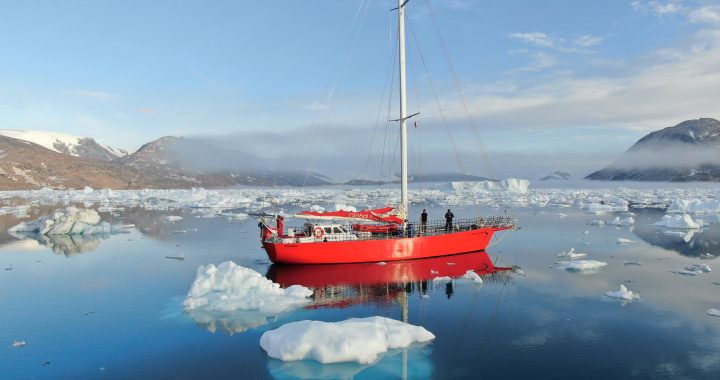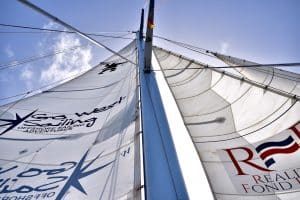Just in via Satellite; Global Surveyor Captain Danny Drahos received Friday 24th July:
We were tied up to the wall in Olafsvik, approximately 60nm NW of Reykjavik. Olafvik is a friendly, picturesque fishing harbour. We had chosen this port as a starting point due to it being in close proximity to Greenland and a slightly better position to the wind.
My Iceland adventure group had left the previous day and I was working frantically to get GS ready for the new arrivals. First to arrive was our engineer Petr with a new sail! He was soon followed by Peter and Zuzana. The following morning, I picked up the mini-bus and drove 200km to Reykjavik to pick up the rest of my crew. Everyone had been sailing with us before, so I gave a quick introduction and moved onto the safety briefing.
The weather forecast was favourable with N wind up to F7. Ideal for our 50 tons yacht. After topping up fuel from the rather shallow and small fuel pontoon, we were ready to go!
The first 24 hours we had sunny weather. With winds as predicted, we were covering 7nm per hour on average.
On Friday evening we sent our first report to Joint Arctic Command in Greenland.
It was a beautiful sail with a full staysail and the main in first reef.
We had seen a few dolphins but what was very exciting were around 10 whales, some of them as close as 30m from our bow! By Friday night the weather had changed. The Barometer was rising, temperature falling, and we found ourselves in thick fog. It was expected for this part of the Denmark Strait and we already had our routine with the watch system. The watch system is two people on watch for two hours at a time; one on the helm with the other keeping a lookout and watching the radar screen.
The sea is now moderate and we are flying at 9 to 10 kn. We know we can do this for the next few hours but once we get closer to Greenland, where there is a higher risk of icebergs, we will have to slow down.
We should see the coast of Greenland in the early hours of the morning. Very exciting!
Just in via satellite; Global Surveyor Danny, Petr, Petr, Peter, Bob, Zuzana, Ruth, Jendys, Andy and Ruth. Received Saturday 25th July:
Saturday morning in the Denmark Strait was very foggy and the night was really cold. We were under staysail and the main was in first reef. GS was flying through moderate seas. We could see 10 knots on the GPS! The atmosphere on the boat was fantastic. Loud music in the cockpit whilst Bob was baking, cooking and frying. Around midday the sky started clearing up and the wind was dying down. We were now approximately 80 nm from the Greenlandic coast and I was expecting the first icebergs soon, but first we saw whales! A pair of these large mammals were playing close to our starboard. Everyone was on deck taking pictures. It was only getting better! The sun was shining and on our port bow appeared a large iceberg! Before we knew it we could see them all around us! It is quite the view!
Later on, in the afternoon Andy and Petr were working on deck getting the dinghy ready when Robert shouts “land Ahoy”. The dramatic coast of Greenland was now on the horizon. Steep mountains covered with ice and snow. Greenland hello again, one of the best views I have ever witnessed.
Now it is midnight and I am overwhelmed by the beauty of nature in the midnight sun. Tomorrow morning, we should be anchored at Tasiilaq.
Sending love from Global Surveyor and Eastern Greenland.
Just in from satellite; Global Surveyor Danny Drahos. Received Sunday 26th July:
Greenland here we are!
Saturday night as we got closer to the coast there were many more icebergs, many of which were in our way. You can see the large ones on the radar but the small ones, called growlers, often not. These so-called growlers still weigh tons and can cause significant damage. There were many so we sent Bob to the bow. It was a very cold night, Bob was standing on the bow for hours, eventually he was replaced by Zuzana warning the helmsman every time we had a big chunk of ice on our collision course. Around 3am we were passing Kulusuk with all the marked and unmarked rocks of its southern shore. The decision was made earlier to go straight for Tasiilaq, the capital of Eastern Greenland with 1600 inhabitants.
By 6am, with the sun shining over the snowy mountains, we had sneaked between rocks and icebergs into the fjord formerly known as Kong Oscar Haven. Despite being there a couple of times last year I was again taken away by the beauty of this place. A little, colourful town with houses spread over the rocks covered with flowers and surrounded by snow and ice covered mountains. And the sun! Shining the bluest sky you can imagine. Wow. The effect of this place is impossible to describe. I love it here!
As I tried to take it all in, a message via Iridium from our superb shore-based support Victoria came in. Our covid retest is arranged for midday with a Danish doctor in a little local hospital. Now for a wee rest and after that the covid test Danish/Greenlandic style!
Just in via satellite; Danny Drahos. Received Sunday 26th July:
On Sunday morning it must have been 18 degrees in Tasiilaq whilst outside of the fjord was absolutely freezing! Inside we were walking in t-shirts and shorts overlooking icebergs floating in the bay. The microclimate of this place is unbelievable!
The appointment for our Covid test was at 11am so we had to stop gazing and hurry. It was the same as in Iceland; apart from obligatory tests you would not know that Covid ever existed. I was really surprised that we could get tested in such a remote place.
By eleven o’clock we were knocking on the back door of a tiny hospital.
Soon we were in the hands of a Danish doctor who was looking quite unsure what to do. After ten minutes of hesitation we were given some forms (in Danish), to fill out. Fortunately, a chatty friendly Norwegian doctor just came out of the hospital. Ten minutes later, with his help, all our paperwork was done. The Danish doctor in charge still seemed confused and we were asked to come back in one hour. On the way to the harbour we met another Dane, a former teacher that had been settled here for many years. After a couple of minutes of chat, we understood what was going on. We were the only boat and only foreign people that had arrived since the start of the pandemics! We were probably also the first people to get tested here!
Anyhow, later on that day the samples were taken and we were told that the results will arrive the next morning. We were free to go but we were told we should “not do any hugging with native folk” (real words). Well that was easy so off we went for a walk to the mountains and wee swim in the freezing water of the lake in the valley of flowers.
The next day we topped up the water and set sail for Sermilik fjord. We had arranged with Victoria to contact the hospital to get our test results and pass the information to us over Iridium. As soon as we were out of the fjord, we were completely absorbed by navigating between icebergs and rocks in almost completely uncharted territory. Sermilik fjord is allegedly the most productive fjord in Greenland for icebergs; approximately five percent of all Greenlands icebergs come from here. I remember what a surprise this fjord was to me last year and it is again.
It is out of this world!
The large fjord is surrounded by massive mountains covered in snow and glaciers. The water is covered with icebergs of all sizes including magnificent giants the size of a football pitch! The deeper we got in the fjord, the thicker the ice cover got. Soon we were moving at one knot trying to make our way through the ice cover. It’s a real wonderland, unforgiving but beautiful beyond imagination. All the other guys onboard are in Greenland for the first time and I think what they are seeing has totally exceeded their expectations. Thousands of pictures have been taken.
It seemed to be much more challenging this year compared to last as there is now much more ice. I knew from last year the progress towards our chosen anchorage would be slow and we needed to be really careful not to get stuck in the ice. It’s complete wilderness and none of us have time to wait in the frozen boat for next summer.
I was really glad that the forecast was very mild; if there was any risk of wind, it could potentially blow ice back into the fjord. If that was the case, we would have to abandon our plan to get all the way to the edge of the glaciers where icebergs are born.
Around 6pm Greenlandic time we had found the bare anchorage deep in Johann Petersen fjord. It was almost completely covered in ice, so we set an ice watch for the night. The ice-watchers task is to keep an eye on openings in the ice cover just in case they start closing. The view is stunning. We are looking right at the head of the fjord where there is a giant wall of ice, it’s a glacier. All day we could hear loud thunderstorm like bangs as glaciers were moving and icebergs were braking off.
It’s late night, some of the guys are fishing on-deck and Peter is trying to take aerial pictures of the giant whales that are pottering a few hundred meters away. Adam and Ruth are cooking and Andy is getting ready for his first ice watch. I’m really looking forward to tomorrow. What a great day we had.
Ps: Victoria texted at midday that eight of us are negative, but the Danish doctor was ragging as Robert and Jenny supposedly did not show up for their test! I texted back that it’s impossible as I actually have a picture of Robert with the testing stick deep in his throat and the Danish doctor holding the end of the stick. Also, Andy swears that he was watching whilst Jenny was tested.
A few messages later it was confirmed that the tests were just lost. They were found and the results would come soon. At this point we have still not got the results, but we are pretty positive that the guys are as Covid-negative as the rest of us. We have all spent the last week together in the close quarters of Global Surveyor and everyone was tested in Iceland anyhow.
Just in via satellite; Global Surveyor Danny Drahos. Received Tuesday 28th July 2020:
Well, another day started far earlier then expected or wanted for that matter. Around 2am Greenlandic time, Robert came to wake me up as there were two quite large icebergs coming towards our bow pushed by flood tide. He said that they were about 20 minutes away by his estimate. Five minutes later I was on deck and icebergs were already at our bow touching our anchor chain. I really hoped to pull the anchor up before it was too late as it could get stuck underneath them. It would have been painful to lose our 14kg CQR.
By the time the anchor had come on deck our bowsprit was literally sticking into the progressing iceberg. We reversed back and started checking if we could drop the anchor again on the other side, but the ice was piling up and our escape route was narrowing. The decision was made to make our way closer to the middle of the fjord and head as close to the glaciers as we could. I think there were 4 of us on deck. The rest were sleeping; missing our exciting escape! Ice/anchor watch really is a necessity.
It’s Greenlandic summer so despite it being 3am, the sun was again shining and it was another beautiful day. The tide should soon turn to ebb, so I was gaining more confidence that it was safe to continue deeper into the fjord. It was a very slow progress and it became more often that we had to use a long pole to push smaller pieces of ice away to create space for Global Surveyor.
Two hours later we were looking at a giant iceberg floating and two massive heads of glaciers. It was glorious sunshine and we were enjoying the view. Ice cover was now probably 80% and we could not continue further. After half an hour of drifting with ice we were starting to realise that the ice was actually closing in on us again, so, unfortunately, we had to turn back. Progress was extremely slow; there were two guys on the foredeck with poles and one with a hand-held radio giving the helmsman directions. Often it took a fair bit of hesitation to decide which way to go. It took us eight hours to do 15nm. Once we had passed our anchorage from the previous night, we drove our bow onto a small flat iceberg to take a break. We flew the drones to get pictures of the unbelievable scenery.
By four o’clock that afternoon we were back in Sermilik fjord. We were trying to cross to the other side by finding the narrow channel leading to the next fjord where we hoped to anchor outside the little village of Tiniteqilaaq. A couple of seals were pottering around and the icebergs were absolutely gigantic. We were now progressing faster as we had more free water available. My biggest worry was that the hole in the wall was going to be blocked by ice and we would have to sail all the way back through the open ocean. Fortunately, that was not the case and we were soon approaching our destination. Meanwhile, a big iceberg, about 100m from us, broke and big chunks collapsed and crashed into the sea. The noise, the wave and feeling that power of nature is pretty amazing to say the least!
Tiniteqilaak is a tiny village of 60 inhabitants with million-dollar views over the fjord. It has a tiny harbour enclosed by a little bay with a narrow entrance. Nothing is charted and it’s full of rocks. Although I was here last year the entry was still quite tricky. After passing the small island with barking Inuit dogs that are left there for the summer, we had to do a fair bit of manoeuvring to get through the rocks and shallows. I will definitely make sure that this track is saved in the memory of my plotter to save me loads of stress on the way out. Despite being on high water we had a couple of times with just over three metres on our echo-sounder – our draft is 2.95!
Eventually we were outside of the village and the depth increased to 20 metres. The anchor is now down and crew is getting ready to go ashore. This is a village of hunters and fishermen and we are running short on fresh meat. We all know which meat we will be able to get here. Slightly controversial but you know…”When in Rome do as Romans do!”
Many regards from the village with arguably the worlds best view.
Danny and crew
I will send pictures soon!
Continue onto Part 2


 From souther Itajai to Salvador via Rio de Janeiro
From souther Itajai to Salvador via Rio de Janeiro
